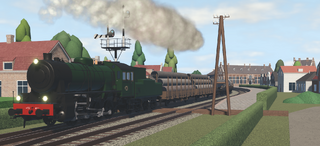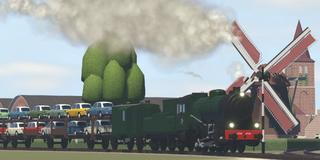| NS 4700 | |
|---|---|
| by Supersnel11 | |
| Price | ƒ145.000 |
| Level | 40 |
| Statistics | |
| Type | Freight |
| Top Speed | 70 km/h |
| Weight | 128 tons |
| Capacity | 520 tons |
| Length | 19,5 meters |
The NS 4700 was a class of Swedish D (0-8-0) goods locomotives used by the Nederlandsche Spoorwegen. They were ordered by the Dutch government without the knowledge of the Dutch Railways.
Livery
The NS 4700 is available in the standard Nederlandsche Spoorwegen green and has an additional livery with an austerity smokebox door, and other small differences.
Historical details
Order & Delivery
The Second World War had dire effects on the amount of available locomotives of the Dutch Railways. In an attempt to aid them, the Dutch government, in London, ordered 50 locomotives at the Swedish factory Nydqvist & Holm Aktiebolag (NOHAB); 15 2'C express locomotives (NS 4000) and 35 D goods locomotives in 1942. The only specifications the Dutch government gave NOHAB was that the capabilities of these 50 locomotives should be similar to those of existing Dutch locomotives; the goods locomotive had to be similar to the specifications of the NS 4600 they provided.

With nobody being certain when the War would end, NOHAB waited with the start of manufacturing until the end of the war was in sight. To save time, NOHAB decided to base the Dutch locomotives on pre-existing Swedish designs, rather than designing them from scratch. The basis for the 4700s was the M3b types of the Trafikaktiebolaget Grängesberg–Oxelösunds järnvägar (TGOJ), to which the 4700s were practically identical. They would be the strongest steam locomotives NS ever had (ignoring the BR 50s which only served briefly). The first locomotives out of the 50 ordered were NS 4702 & 4703, which arrived in July, 1945.
The 4701 was originally not equipped with its number plates because the numbers these locomotives would carry were unknown at the time that NOHAB started manufacturing them. Instead, the plates and buffer beam numbers had 'ZG1', which stood for "Zware Goederenlocomotief 1" (Heavy goods locomotive 1). These plates were replaced with the correct ones prior to the delivery, though one of them currently lies in the Dutch railway museum.
NS was not pleased with the delivery speed of the engines, especially not by the fact that they were transported by land rather than sea. NOHAB had chosen for that because there was a big shortage on ship capacity at the end of the war, but this didn't stop NS from sending complaints. Additionally, NS considered to halt the order of any further locomotives in October, 1945, and sell the ones they did have because they had hired a large amount of Austerity locomotives from the British War Department, which were much cheaper to buy. At the end of November '45, NS, now owning all 35 4700s, wanted to sell 30 of them. The plans for electrification would mean that these new, expensive machines were expected to have short working lives and high depreciation expenses. Additionally, parts differed from those of both the Dutch and British engines. And yet, the 2'C express locomotives were very welcome. The selling attempts failed and all 35 were put into service.
Their working life
After the NS 4702 and 4703 arrived in July, 1945, they were initially used for a few passenger trains between Rotterdam and Amsterdam and goods trains around Amersfoort. Four more locomotives arrived, with two months between each. These first six were housed at Amersfoort and were sent further out to the destroyed bridges near Deventer and Zutphen. NS 4704 had the honours of pulling the first Pullman train to Brussel. After the bridges were repaired, they were sent further East. The remaining 29 locomotives were delivered in 1946 and were also stationed at Amersfoort.

In their early years, they were mostly used for passenger trains. The first continuing train Amsterdam - Paris (through Utrecht and six other Dutch stations) were pulled by 4700s up to Utrecht.
In the spring of 1947, a few of the locomotives were moved to Maastricht, where they would stay until the end of steam traction. The rest of the series got stationed at Roosendaal, Amsterdam and Eindhoven after Amersfoort. This did not last long, all but the Maastricht 4700s were stationed at the depots Eindhoven and Heerlen by the end of 1947. They would join the others at Maastricht in 1952. An NS 4700 would be stationed at Amersfoort or Roosendaal occasionally, throughout the 1950s. Amsterdam got one in 1952 to help with the hump yard there, but the last big jobs of the series were the coal trains in Limburg.
The first eight were withdrawn in 1955, followed by another ten in 1956 and yet another 15 in 1957. Two of the 4700s, 4731 & 4743, still pulled some coal trains on December 31st, 1957. These trains were, with the exception of the official goodbye ride with NS 3737 a week later, the last normal NS steam trains. The 4731 & 4734 would be put out of service on the 27th of February, 1958, together with the other nine remaining NS steam locomotives.
Technical details
The NS 4700 were originally equipped with Westinghouse-brakes for both the locomotive and tender, connections for steam heating at the back of the tender, later at the front too, the firebox was secured with two Richardson-mechanisms, Deuta-speedometers, a steam-powered brake, electrical lighting powered by an Asea dynamometer next to the smokestack, an Asea-lubricator, two Type 10 Gresham & Craven-injectors and a welded, steel firebox.
The cab was entirely enclosed and designed to be comfortable for the stoker and driver. All of the meters were located behind the regulator so the driver could see what was going on and where he was going in a single glance.
The boilers had a steam pressure of 12 kg/cm², which was low for the time. In 1947, NOHAB delivered a reserve boiler with a factory number that had already been given to the frame of NS 4702. The stays of the fireboxes only drilled on the outside and the crown stays were, against Dutch regulations, not drilled at all. The boiler tubes were welded to both tube plates, whereas the usual Dutch method was to weld the tubes to just one tube plate, the one that was part of the firebox, but roll them into the plate at the front.
The original steel firebox gave troubles with maintenance. The steam generation was great on arrival, but worsened over time by the deposition of residue and boiler scale. The arrival of the wrongly numbered boiler in 1947 created opportunities to give the boilers copper fireboxes. These replacements happened between 1950-1952, along with the swapping out of any non-standard parts. This included replacing the smokebox door with those of withdrawn NS 4300s and 5000s. The firebox door was a sliding door placed on rolls, which made it very easy to operate.
The steam brake only worked on all but the front axle and had to be operated separately from the Westinghouse-brakes on the locomotive and tender.
The locomotives had a bar frame. The wheel bearings of the front axle were connected together and could move 12,5 mm to either side. All axles, those of the tender included, ran on SKF-rolling bearings. The locomotive's resistance was very low as a result; they could be moved with only one to two atmospheres of pressure. The steam dome and sand dome were placed under a single cover.
The two NOHAB series had a third number plate on the backside of the tender in accordance with Swedish customs. Other Dutch locomotives only had a painted number on the back of their tenders. All cylinders worked on the third axle, which had its own crank pin to avoid troubles with the second axle. All cylinders had their own independent valve gear.
The first four 4700s were delivered with flange plows, but these were removed as they were both unnecessary in the Netherlands and fell outside the locomotive's profile. Their original maximum speed was 55 km/h, but they drove so well that this was rapidly changed to 70 km/h.
Trivia
- The NS 4700 is a mid-high level heavy freight locomotive, with a favourable speed for a freight locomotive, and a hefty capacity for cargo.
- The original version of the model featured only one electric lamp (on the smokebox door), with the rest being regular oil lamps.
- The dynamo sounds were added much later to the NS 4700, on version 0.4.35.
- The highest speed chuffing loop features birds chirping in the loop.
- In version 0.7.6, the NS 4700 received a temporary snowplough livery for the winter season of 2023.
- The NS 4700 has been available since version 0.1, the launch of the game.
Gallery
-
An NS 4700 with a couple wagons loaded with construction materials speeds through the Kesteren platforms.
-
NS 4709 exits the car manufacturing plant of Kroosdrichem.




